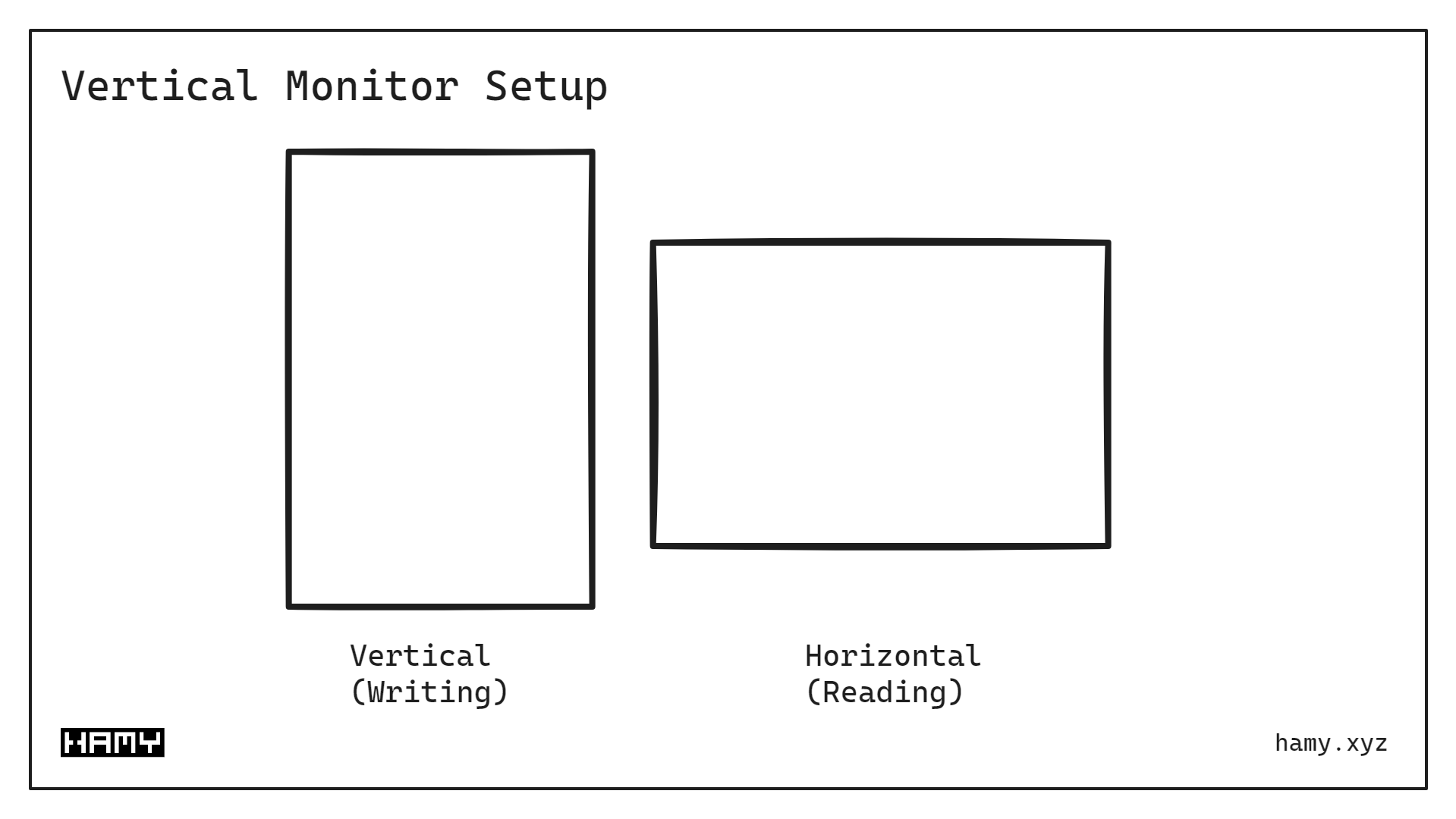Essay - Published: 2024.01.17 | create | observe | productivity | research | software-engineering | tech |
DISCLOSURE: If you buy through affiliate links, I may earn a small commission. (disclosures)
I've experimented with many methods to make my coding workflows more productive throughout my career as a software engineer. Some of these work. Most of them don't.
But one strategy has worked so well that I've stuck with it for the last 5 years - a vertical monitor.
In this post I'll share some reasons why I find vertical monitors so valuable and why I think it's the optimal setup for writing code.

My go-to setup is one vertical monitor on the left and one horizontal monitor on the right.
The biggest challenge for software engineers is focus. Focus time for deep work, focusing on the highest priority thing, not getting distracted by ineffective meetings, Slack messages, or the latest urgent-but-not-important bug.
Coding is deep work. Before you can build something you must load the context in which you'll be building. Each distraction risks pulling you out of this context thus requiring another reload before making progress - we call this a "context switch".
A vertical monitor can't block these from happening - they're a fact of life in most work environments. But it can serve as a useful technique for reducing their prevalence.
I think of it kind of like a "focus mode" in a text editor - it removes all of the extra visual clutter so you can focus on the thing that matters - the words. This focus mode doesn't actually remove the distractions but it hides them such that there's less chance of it interrupting you.
Vertical monitors are not very good at split screens and they're not very good at consuming videos. This is a feature, not a bug as those things are almost always distractions.
So by choosing a vertical monitor, you're choosing a permanent "focus mode" for one of your screens. Since focus is often our most impactful bottleneck, this is a useful optimization.
Text is a vertical-native format. To prove this just look at how text is presented in books, websites, and phones - it's vertical. In fact we read text better when it's width-constrained because it's easier for our eyes to scan.
Coding is a text-based discipline. Most of what we do as software engineers is write - writing the code, writing design docs, writing messages, etc.
So it should come as no surprise that using a vertical screen for a vertical-native format is good actually. It allows you to see more of your code at once which allows you to keep more relevant info in context further preventing context switches.
Vertical formats are better for reading and writing text. Since code is a text-based discipline, it makes sense that vertical screens help reading and writing.
Many software engineers spend most of their day sitting at their desks (I certainly do). But human bodies aren't really built to do that which is why so many people end up with repeated-use pains.
This has led to the rise of the ergonomics industry to try and solve for these pains in the forms of special keyboards, mice, and recommended desk configurations. For the most part these work by reducing common motions that most frequently lead to issues.
It's useful to have multiple monitors as a software engineer - it allows you to keep more things on screen at once which can help to keep more relevant information in context at the same time.
The problem with having two horizontal monitors next to each other is that it forces you into bad ergonomics. A typical 27" monitor laid out side by side is so wide you are forced to move your neck to go from one screen to the other. This neck craning is a common source of long-term neck / back pain over years of repeated use.
A vertical monitor provides a nice middle ground. You still get your extra monitor so you can keep more things in context but it's not so wide that you must crane your neck to see - it fits just inside your horizontal vision bounds so navigation can be done just w your eyes. This means less neck / back problems long-term.
The practice of ergonomics is all about reducing issues from repeated actions. A vertical monitor prevents a whole class of neck / back issues long-term.
I love my vertical monitor setup - it allows me to focus better with less distractions, is excellent for writing text, and has probably saved me a ton of pain over the years. I don't always get to use it (e.g. if I'm using a hot desk / don't have an extra monitor) but when I can it's always worth the configuration effort.
If you liked this post you might also like:
The best way to support my work is to like / comment / share for the algorithm and subscribe for future updates.